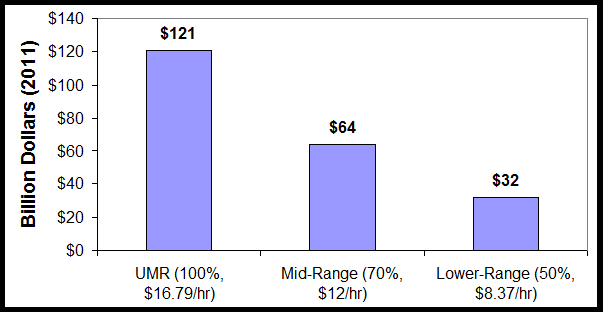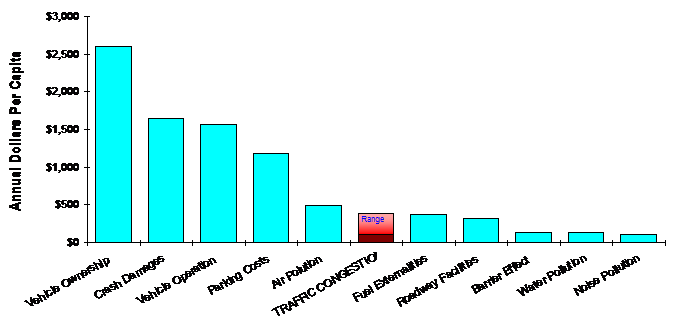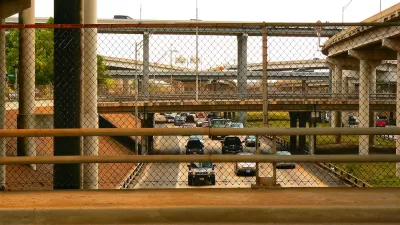Conventional transportation planning tends to exaggerate congestion costs and roadway expansion benefits, and undervalues other transportation solutions such as improving alternative modes, pricing reforms and smart growth policies.
The Texas Transportation Institute’s annual Urban Mobility Report (UMR) is a commonly cited source of congestion cost estimates. Last year I published a report, Congestion Costing Critique: Critical Evaluation of the ‘Urban Mobility Report’ that identified various technical problems with the UMR’s methodologies.
Lead UMR author Dr. Tim Lomax subsequently posted his responses in a document, Congestion Measurement in the Urban Mobility Report: Response to Critique by Mr. Todd Litman. The revised version of my Critique includes Table 6, Point-Counter-Point Dialogue, which summarizes my specific concerns, Dr. Lomax's responses, and my latest comments. It is too long to post here, but I encourage you to read both documents so you to make your own judgments about these issues.
My analysis indicates that the UMR tends to exaggerate congestion costs and roadway expansion benefits, and undervalues alternative congestion reduction strategies. It uses higher baseline travel speeds and travel time values than most experts recommend (in fact, its baseline speeds often exceed legal speed limits on the roads evaluated), ignores the increased fuel consumption, pollution emissions and crash severity caused by high traffic speeds, ignores the increased external costs of induced vehicle travel, and ignores many co-benefits provided by alternative mode improvements, pricing reforms and smart growth policies. As a result, the UMR’s congestion cost estimates should be considered upper-bound values – when using such estimates analysts should apply sensitivity analysis that also include middle and lower-bound estimates.

The Urban Mobility Report’s $121 billion cost estimate is based on higher baseline speeds and travel time unit costs than most economists recommend. The lower-bound estimate in this graph is based on 50% of baseline speed and the U.S. Department of Transportation’s lower travel time unit costs, reflecting reasonable lower-bound values.
I believe that to be more accurate, the Urban Mobility Report should either become more comprehensive and multi-modal or be renamed the Urban Congestion Report to more accurately indicate its scope. Cities are, by definition, places where many people and acivities occur close together, and so require multi-modal transport systems to function efficiently. The UMR only measures one factor: motor vehicle traffic congestion. This reflects an outdated planning paradigm which assumed that “transportation” refers only automobile travel, and the only planning goal is to maximize traffic speeds, ignoring other modes and objectives. Efficient urban transport planning must consider a wider range of modes, impacts and options, and recognizes conflicts between various objectives.
Why does this matter? What problems will result if urban transport planning incorporates exaggerated congestion cost values?
Comprehensive and accurate valuation of congestion costs is important because urban planning often involves trade-offs between conflicting objectives such as between traffic speed and safety, and between automobiles and other forms of access. For example, expanding urban roadways may reduce congestion but tends to create barriers to active modes (walking and cycling), and since most public transit trips involve walking links, it also reduces public transit access. Exaggerating congestion costs undervalues other impacts and modes, leading to economically excessive roadway expansion and underinvestment in alternatives, resulting in a transport system which is less efficient, diverse, affordable, safe, healthy and equitable than optimal.
Congestion costs are actually moderate overall, larger than some but smaller than others. For example, annual per capita U.S. congestion costs are estimated to total between $110 and $390, compared with about $4,000 in vehicle costs, $1,500 in crash damages, $1,000 in parking costs, $500 in air and noise pollution costs and $325 in roadway costs, as illustrated below.

Congestion cost estimates range between $110 and $390 annually per capita, depending on analysis methods. Even the higher estimate is moderate compared with other transport costs.
As a result, a congestion reduction strategy may be worth far less overall if it increases other costs, and worth far more if it provides other benefits. For example, a roadway expansion may seem cost effective considering congestion impacts alone, but not if it induces additional vehicle travel which increases parking congestion, accidents and pollution emissions. Conversely, alternative mode improvements may not seem inefficient considering congestion reductions alone, but are cost effective overall when co-benefits (parking cost savings, traffic safety, and improved mobility for non-drivers, etc.) are also considered.
It is also useful to compare congestion with other factors that affect the amount of time people spend traveling. For example, according to the UMR, Washington DC’sautomobile commutersexperienced 67 average annual delay hours, but since that region has only 43% automobile commute mode share, this averages just 29 hours percommuteroverall. In contrast, Houston’sautomobile commutersexperience a somewhat lower 52 annual delay hours, but since it has a 88% auto mode share this averages 46 hours percommuter, much higher than in Washington DC.
Exaggerating congestion costs and undervaluing other congestion reduction strategies tends to result in economically excessive roadway expansion, and underinvestment in alternative modes, such as grade-separated public transit, and demand management strategies, such as more efficient road and parking pricing. This mattered less during the twentieth century when VMT was growing rapidly, so there was little risk of overbuilding roadways – any excess capacity would eventually be used, it was simply a question of when. However, now that automobile travel has peaked in most developed countries, and society is increasingly concerned about the external costs of excessive automobile dependency, overbuilding has become as economically harmful as underbuilding roadway capacity.
Comprehensive and accurate analysis of impacts (benefits and costs) is the key to rational planning. Planners should strive to apply the best evaluation methods and explicitly identify potential omissions and biases.
For More Information
Eric Dumbaugh (2012), Rethinking the Economics of Traffic Congestion, Atlantic Cities.
Susan Grant-Muller and James Laird (2007), International Literature Review of the Costs of Road Traffic Congestion, Scottish Executive.
Todd Litman (2012), Smart Congestion Relief: Comprehensive Analysis Of Traffic Congestion Costs and Congestion Reduction Benefits, Victoria Transport Policy Institute.
Todd Litman (2013), The New Transportation Planning Paradigm, ITE Journal, Vo. 83, No. 6, pp. 20-28.
Todd Litman (2013), Congestion Costing Critique: Critical Evaluation of the ‘Urban Mobility Report,’ Victoria Transport Policy Institute.
TTI (annual reports), Urban Mobility Report, Texas Transportation Institute.
Ian Wallis and David Lupton (2013), The Costs Of Congestion Reappraised, Report 489, New Zealand Transport Agency.

Planetizen Federal Action Tracker
A weekly monitor of how Trump’s orders and actions are impacting planners and planning in America.

Map: Where Senate Republicans Want to Sell Your Public Lands
For public land advocates, the Senate Republicans’ proposal to sell millions of acres of public land in the West is “the biggest fight of their careers.”

Restaurant Patios Were a Pandemic Win — Why Were They so Hard to Keep?
Social distancing requirements and changes in travel patterns prompted cities to pilot new uses for street and sidewalk space. Then it got complicated.

Platform Pilsner: Vancouver Transit Agency Releases... a Beer?
TransLink will receive a portion of every sale of the four-pack.

Toronto Weighs Cheaper Transit, Parking Hikes for Major Events
Special event rates would take effect during large festivals, sports games and concerts to ‘discourage driving, manage congestion and free up space for transit.”

Berlin to Consider Car-Free Zone Larger Than Manhattan
The area bound by the 22-mile Ringbahn would still allow 12 uses of a private automobile per year per person, and several other exemptions.
Urban Design for Planners 1: Software Tools
This six-course series explores essential urban design concepts using open source software and equips planners with the tools they need to participate fully in the urban design process.
Planning for Universal Design
Learn the tools for implementing Universal Design in planning regulations.
Heyer Gruel & Associates PA
JM Goldson LLC
Custer County Colorado
City of Camden Redevelopment Agency
City of Astoria
Transportation Research & Education Center (TREC) at Portland State University
Camden Redevelopment Agency
City of Claremont
Municipality of Princeton (NJ)





























